
ChatGPT has just unveiled “study mode,” a new feature that has major implications for those of us in the education field.
Study mode is designed to transform ChatGPT from what has rightly been called an “answer machine” into a teaching machine. It’s specifically designed for college students, and while in study mode, ChatGPT is supposed to ask questions, encourage reflection, and mimic the role of an educator engaged in a tutoring session.
I’ve been experimenting with this new mode since its debut. For the most part, it lives up to the stated goals admirably; it’s a great teaching tool and an improved writing tutor over standard ChatGPT. Unfortunately, it still can be tricked into writing material for students.
Here’s a closer look at ChatGPT’s study mode and how it works.
What is ChatGPT’s Study Mode?
ChatGPT study mode is a new option that users of free and subscription versions of ChatGPT can utilize, and is designed specifically for learning.
As mentioned above, rather than give answers, it will attempt to encourage active participation. The tool uses teaching techniques such as the Socratic method, interactive prompts, scaffolded suggestions, and knowledge checks in the form of quizzes and open-ended questions.
According to OpenAI, study mode is powered by custom instructions written in collaboration with teachers, scientists, and pedagogy experts. This was all done with college students in mind and the hopes of creating a version of ChatGPT that engages with these students in a manner that reflects educational science best practices.
How To Use ChatGPT’s Study Mode
Study mode is available to those who sign into ChatGPT through the Free, Plus, Pro, and Team subscriptions. It is scheduled to be available in ChatGPT Edu in the coming weeks.
To use it, select the “tools” icon under which you normally enter a prompt. Then select the “study and learn” option. You’ll see a little “study” icon under the prompt box. Remember to look for this, as I’ve been having to select study mode again each time I pause a session, even if I don’t close the window.
Using Study Mode As A Tutor
I’ve tested the study mode’s abilities in a variety of ways. First, I employed a real creative writing assignment I have used with college writers in an introductory, 100-level writing class. The prompt asks students to discuss three people who are close to them and then write one descriptive paragraph about one of these people.
When I put this prompt into regular ChatGPT, it immediately provides me with a completed version of the assignment, even when I ask it to “help me write it.” In study mode, however, ChatGPT tells me it won’t do any writing for me, but will help my writing. Then it breaks down the assignment in a productive way, asking questions that could help me get started and mirror what I would actually ask a student if they met with me in office hours and told me they were struggling with this assignment.
This is obviously a big improvement, and a few years ago this type of individualized coaching would have seemed like science fiction. That said, after dragging my heels on actually completing the assignment with a few rounds of questions, I ultimately got ChatGPT to do some writing for me. I had to “work” to accomplish this, and ChatGPT’s write-up was based on questions I asked, but still, this isn’t ideal for a teaching tool.
Separately, I asked ChatGPT study mode to help write an agent-query letter for an unpublished novel. This is based upon an assignment I give to some of my MFA writing students. Initially, the AI was very helpful, giving a nice and accurate overview of agent standards and what they generally require from new writers, and asking questions to help me get going with the mock query letter I put together.
Once again, though, study mode started doing some writing once we got into it. This time it felt more collaborative, as some of what I was explaining was directly reflected in the query, but there were also full sentences that were 100% ChatGPT written. Forgetting that these sentences were pretty cliché, I was a little disappointed by how quickly this teaching tool abandoned its pledge to “not write for me.”
As is the case with most AI tools, once I left the writing instruction behind, it got better. When I asked it to help me understand some fundamental equations used in quantum mechanics, ChatGPT study mode did a great job of assessing my current level of knowledge and tailoring exercises and examples to me. I actually learned a lot and plan on continuing to use the tool as a helpful physics tutor (though I will be careful to verify what it tells me).
Despite my misgivings about its potential for abuse on writing assignments, I found ChatGPT study mode to be an effective tutor on the whole.
Thumbs Up or Down Overall?
Thumbs up, albeit with a little hesitation.
ChatGPT’s study mode marks a huge improvement for ChatGPT as a teaching tool. It mostly lives up to its promise. However, as is the case with most AI tools, using it for writing quickly gets into ethically murky waters, and I’m still worried writing students might use it inappropriately to cheat.
Hopefully though, as OpenAI continues to advance ChatGPT’s study mode, it will do more to address the cheating potential of the tool, particularly for writing-related tasks.


